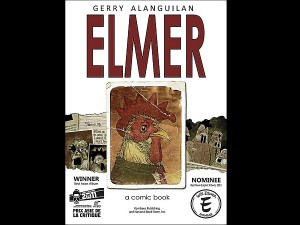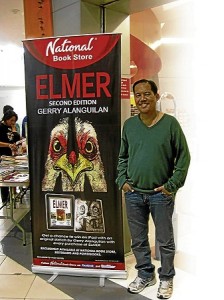
Such is the world of “Elmer,” the multi-awarded graphic novel by Gerry Alanguilan, now on its second edition. And while on first glance, one would think that a comic about a bunch of chickens would lend itself well to humor, “Elmer” is actually a moving tale about family and legacy, which is why it was nominated for an Eisner award, the comic equivalent of the Oscars. We sat down to chat with its creator on the morning of the second edition’s launch last Oct. 15 to talk chickens.
How would you describe “Elmer”?
It’s about my speculation of what it would be like if chickens had become intelligent and started talking, and what would happen to the world and us as people, if that happened.
Did you have the idea to use chickens in a comic for a long time?
Actually, matagal na akong gumagawa ng comic strips about chickens. Since 1997, gumagawa na ako ng strips, ang title niya, “Stupid Chicken Stories.” Lumabas siya sa old photocopied comics ko. Short strips lang siya that depict the stories of chickens, ang mga crazy stuff that happened before.
When you came out with the first issue, what was the reaction?
Yung first book, sa loob ko, personally I liked it, but I didn’t know how people would react because it’s different. Tapos nung in-announce ko pa, sa 2005 Komikon, that I was planning a comic book about chickens, kasi may nagtanong dun, “What’s your next serious comic project after ‘Wasted’?” Sabi ko, “I’m thinking of doing a comic about talking chickens.” They didn’t believe me, ’kala nila kalokohan ulit. And that was a preview of the reaction to the first issue, ’kala nila funny animal story. But it was so unlike the experience after reading it.
Later on, “Elmer” was called “the great Filipino novel”. Did you plan on writing something like that?
Oh no, with every project na ginagawa ko, I just try to do my very best in terms of drawing it, writing it. Talagang praning ako while writing it. In the first issue, I wrote it out for a couple of days, and then I let it rest for awhile, then binalikan ko siya. Edit, edit, edit, add, subtract. After a couple of months, I was able to come up with a script that I felt was good enough, OK na for me.
Now that it’s the second printing, are you fully satisfied with what came out?
Actually, I can’t look at “Elmer,” I can’t look at it too much. Minsan gusto kong ulitin yung drawings, pero at some point I have to let it go and do something else. I know hindi ako magiging masaya. Even when it was getting recognized abroad, I was like, “Sigurado kayo?” Medyo I want to go back to it and redraw, pero ’wag na.
You don’t want to do an Elmer 2 or a spin-off?

So what’s new in the second printing?
Slightly different cover. Nandoon yung mga bagong recognitions niya. Inside basically same content pero may bagong afterword and then siyempre I had to talk about what happened after the first edition, bakit nagkaroon ng second edition, and then nagkaroon ako ng sample script, so more on the creative side. How I approached the writing, how I approached drawing it, and then merong illustrations that were previously only available in the limited edition boxed sets. And sa pinaka-last page, may mga photographs depicting yung journey of “Elmer,” may mga signings and stuff.
Part of that journey was having the book recognized internationally. So how was that for you?
Nung lumabas yung first issue ng “Elmer,” yung una kong ginawa, aside from distributing it here sa Philippines, naghanap kaagad ako ng publisher abroad who would possibly be interested. Nag-send ako ng copies sa mga editors, sa mga artists, sa mga writers, pati na rin sa mga online comic book columnists who would write about it. Kasi I want my book and my stories to be read abroad din.
As any storyteller would like, gusto niyang mabasa ang mga stories niya. Yan ang purpose ko talaga, I want my stories to be read all over. So naghanap ako ng publisher noon, and may mga interested parties, pero walang kumakagat. So for the next four years, I tried sending and sending the subsequent issues until merong gustong i-publish. And when it got recognized, parang I was very happy for it, kasi unang-una, it would get read.
Is this the approach for your future works, more thinking, almost cerebral?
Di naman cerebral, kunwari, the Jose Rizal project I’m currently working on is for all ages. Puwede siyang basahin ng kids until old people and I want the story to be presented as clear as possible, as concise as possible, walang confusion. I want it to be as easy reading as possible, but it’s very difficult to do. Kasi, sino ba si Rizal? Bakit ganito ang Pilipinas? So I wanted to present my ideas as clear as possible and yung process of doing that is very difficult.
How is that compared to the inking you do for US comics?
Yung inking na ginagawa ko for Marvel Comics, I consider that my day job. I count myself lucky kasi yung ibang comic book artists, ang day job nila is advertising, and then they do comics sa free time nila. Ako ang day job ko, comics din and it just so happens I’m working for Marvel and DC as part of a team that assembles super hero comics. And I take great satisfaction that I’m working with Leinil [Francis Yu] and Whilce [Portacio] and other artists, working on “X-Men” and “Avengers.”
Lastly, with more comic book companies going digital as a way to get more readers, do you see yourself doing something similar with your projects?
Medyo old-fashioned kasi ako in terms of comic books. Gusto ko pa rin yung books. At the same time ayoko namang i-deny na nangyayari ito, kasi it’s happening (the shift to digital comics), and for older people like myself who grew up with books in print, hindi mawawala yun. Pero yung mga kids right now who grow up on gadgets and iPads and stuff, wala silang personal connection sa books. Hindi sila exposed to it.
But I want to stick to books myself. Nagkaroon nga ako ng manifesto sa aking blog (gerry.alanguilan.com) na in case one day, maging digital ang mundo, I’ll be one of the very few people still doing books. I’ll be one of those cranky old people like those na nag-aayos ng typewriter, na may gusto sa vinyl records, I’ll be that old cranky person in San Pablo creating comic books on paper. Pero some of my work is in digital form. Gusto ko naman open ang mind ko doon. Pero yung unang labas talaga ng comic has to be in print.
Na-recognize ko rin na because of the digital distribution of “Elmer,” yung first issue ng “Elmer” was put up online completely and it opened doors for me. Dahil doon, nabasa ang “Elmer” sa Europe and they wanted to publish it there.
That sort of makes you a Philippine ambassador of comics then, doesn’t it?
Oo nga ano! (laughs)

